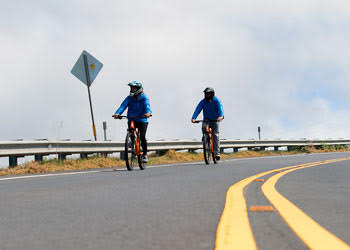Council aims to get handle on Maui downhill bike industry

Decades-old concerns over Maui downhill bicycling have been resurfacing in recent months, and many hope Maui County Council deliberations on the topic will help pave a new, safer path forward.
A measure introduced late last year by Council Member Mike Molina to bolster downhill-tour regulations for the first time in 15 years was discussed Tuesday at the council Government Relations, Ethics and Transparency Committee.
The latest version of the proposal would roll out operation guidelines and make certain violations a petty misdemeanor that’s subject to a fine, imprisonment up to 30 days or both. Ultimately, the item was deferred while community and industry leaders continue work on best practice guidelines.
Some testified Tuesday, urging the council to regulate the industry by spacing out tours, restricting them to certain hours and elevations, and eliminating “loose riders,” or people who think it’s OK to ride in the middle of the roadway.
“Loose riders believe they are on a ride at a theme park and do not behave like real bicycle riders,” said Jack Patnode, a longtime Kula resident off Crater Road.
Another Kula resident, Albert Perez, said that he prefers the tours to be banned completely or restricted areas below Haleakalā National Park from 6,000- to 4,000-foot elevations. Perez is Maui Tomorrow Foundation’s executive director but said he was speaking on his own behalf.
“Bottom line is that it’s very dangerous and creates a lot of stress for residents,” he said. “It’s frightening.”
Some industry leaders, though, pushed back against how the tours are depicted.
“A lot of the testifiers make it seem like we are lawbreakers when, in fact, the bicycles are doing the speed limit for the most part — the vehicles are breaking the law,” said Phil Feliciano of Bike Maui. “The law states that a vehicle must give any cyclist, any cyclist whether they’re on a tour or riding on their own, at least 3 feet, and if they can’t give them the 3 feet, then they are not allowed to pass.”
Others said that local biking companies are working with the community and compromises can be found.
Lewis Upfold, Haleakala Bike Co. chief operating officer who grew up in Haʻikū, said that he’s been seeing “a lot of productivity” after a couple months of working closely with Kula Community Association and other bike companies.
“I appreciate the council for facilitating this discussion because I think it’s done a lot of good for us — as well as the community also bringing together bike companies to set some really good standards,” he said.
Dick Mayer, longtime Kula resident and Kula Community Association board member, agreed. He said a draft ordinance, best practices outline and other suggestions are in the works.
Some of the recommendations include bike groups leaving 10 minutes apart when they depart at the 6,500-foot level, not starting before 8:30 a.m. commuter and school traffic; and enforcing a minimum rider age of 12, among others.
“You will note that we are not including in our proposal many of the provisions in Council Member Michael Molina’s original draft which the KCA board felt went too far towards potentially closing down the bicycle tour industry,” Mayer wrote in an email to committee members. “However, the many recommendations should allow the industry to continue with, hopefully, better relations with our residents and communities.”
Historically, residents in the Kula, Pāʻia and Makawao have long voiced worries over the danger of guided and unguided bicycle tours on narrow, winding roadways, especially on Crater Road during high traffic hours.
At best, arguments over whether bikes or vehicles should have the right of way are debated. At worst, serious injuries and even deaths are tied to inexperienced bikers and dangerous or non-permitted companies.
Just last year, two bicyclists collided on Makawao Avenue during an April tour and a downhill-tour bicyclist lost control and fell over the bike’s handle bars on Haleakalā Highway in June, according to Maui police.








